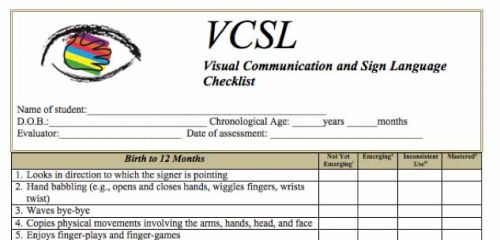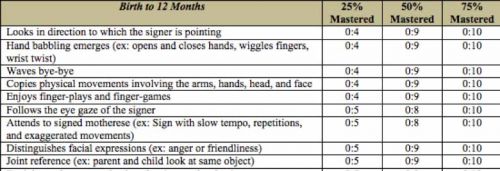Visual Communication and Sign Language Checklist
The VCSL Checklist is the only standardized measure of American Sign Language (ASL) acquisition for young children in the United States. It was created for use by educators (teachers, early interventionists, Deaf mentors) who work with signing children from birth through five years of age. It can be used with older children who are language delayed to identify strengths, weaknesses, and gaps in development. The VCSL Checklist monitors children’s sign language acquisition and helps determine if children are developmentally on track. It provides an indication of whether a child’s language is typical, advanced, or delayed compared to norms, which were created during the standardization process. The VCSL Checklist was based on informal ASL checklists that had been created by Schools for the Deaf, Deaf Canadian organizations, and university researchers. However, none of these informal measures included norms. The VCSL Checklist focused on incorporating existing knowledge and moving it to the next level by collecting data, piloting, and then creating norms based on typically developing native-signing Deaf and hard of hearing children from birth through the age of 5.
Rationale and Content: Some sign language checklists and assessment measures have been created based on existing spoken language assessments that were validated on hearing populations. For example, the McArthur Communicative Development Inventory (CDI) for ASL is based on the English CDI (Fenson et al., 2000). It uses a parental report form that allows parents to check their child’s first words and early grammatical structures. Very few instruments of a standardized nature have been developed for documenting Deaf and hard of hearing children’s visual language development and growth trajectory in ASL. Those that have been funded to create new assessments focused mainly on K-12 students and, unfortunately, the assessments were never widely distributed by developers. The field of Deaf Education needed a comprehensive checklist of visual language development to help teachers establish learning goals, identify gaps in language development, and plan the learning environment so that children could acquire language in developmentally appropriate social contexts.
Test Development and Standardization: Psychologists, linguists, and educators collected and evaluated existing checklists of typical linguistic ASL milestones. These items were aggregated and merged into one draft checklist. Then the VCSL Checklist team, which included three ASL/English bilingual university faculty (both a deaf and a hearing teacher preparation faculty member and a hearing psychologist) collaborated with teachers of the deaf in instrument development. The VCSL Checklist went through several phases to ascertain its effectiveness, accuracy, and success. Table 1 describes the different phases and activities during development.
Table 1: VCSL Checklist Timeline of Development
|
Phases of Development |
Activities |
Results |
|
Year One 2011 |
-Merging of existing ASL development checklists -A two-year pilot by teachers at Kendall Demonstration Elementary School (KDES) -A literature review and feedback by linguists and psychologists |
-Teachers liked the usability of the VCSL and preferred it for classroom use over more complex diagnostic ASL assessment instruments |
|
Year Two 2012 |
-Review by ASL/English Early Childhood Educators of deaf and hard of hearing students -Second review by KDES committee of revised VCSL Checklist -Creation of a signed glossary uploaded to YouTube |
-Categories were created upon recommendation by teachers: “not yet emerging,” “emerging,” “inconsistent use,” or “mastered.” -Modification of VCSL items based on feedback
|
|
Years Three and Four 2012 - 2013 |
-Validation and standardization of the VCSL Checklist -Development of the instructional manual -Translation and filming of the manual into ASL -Production of DVDs
|
-Dissemination of Version One, the manual, and DVDs to schools and teachers who assisted in the validation and standardization process -Distribution by the Center for Visual Languages and Visual Learning (VL2) at Gallaudet University |
|
Years 2014 - 2015 |
-Production of Version 2 -Filming of children signing each item on the VCSL Checklist -Production of DVDs -Production of training materials |
-Dissemination of Version 2 and updated manual in both ASL and English, and a DVD that includes new examples of children producing the items on the VCSL -Trainings offered on the administration and scoring of the VCSL by research team
|
|
Next Steps |
-Plan the second validation study and prepare Version 3
|
|
Initial Validation and Standardization
To conduct the validation and standardization of the VCSL Checklist, we created and online registration process which included informed consent forms, instructions, and background questionnaires to gather data about the teachers, families and children in the norming group. When teachers agreed to participate, they were entered into the registration system and sent a password and a login ID to complete the checklist. All of the children included in the study had their own identification number. Teachers, sometimes in conjunction with a child’s parents, evaluated the child’s language use and completed the online VCSL Checklist based on the child’s current skills. After the information was submitted, the data were merged into the database. Data continued to be collected throughout 2012 on children from birth to 5 years 11 months.A column labeled “Do Not Understand the Item” was included. In addition, at the end of each section there was an open comment section for participants to suggest any missing items or any other concerns.

Norming Group
The VCSL Checklist was normed on native-signing Deaf and hard of hearing children who were acquiring visual language typically as determined by their teachers. The norming group resulted in a total of 83 deaf and hard of hearing children. There were 48 girls and 35 boys. The majority of the children were reported as Caucasian, with 10 African American, 8 Latino, 2 Native American, 2 Asian Americans, and 1 child reported as “Unknown.”
Table 2: Overview of norming group for VCSL
|
AGE |
NUMBER OF CHILDREN |
|
Birth – 12 months |
6 |
|
1 year – 2 years |
8 |
|
2 years – 3 years |
11 |
|
3 years – 4 years |
11 |
|
4 years – 5 years |
25 |
|
5 years – 5 years 11 months |
23 |
Reporting Norms
Items were ordered based on the ages found for each quartile, from youngest to oldest. Norms report the ages found for each quartile. The range of ages across the quartiles tends to be small, varying from less than a 1-month variation to an 8-month variation. Most items have ranges of 3 to 5 months between the 25th and the 75th percentiles. All items were reported as mastered within the age range of the VCSL Checklist.

Strengths and weaknesses of the VCSL
The VCSL is a standardized measure of early sign language acquisition and this should be helpful in helping children establish a strong language base upon which to learn. We would like to conduct a second round of data collection with the goal to expand the data set, which would increase the reliability of the assessment. Some items in the upper age range fall into quartiles that are 8 months in range. We would like to reduce this. We would also like to uncover any items that may be missing in the current checklist.
